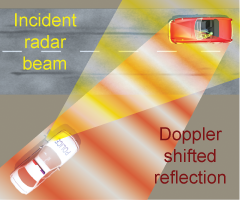|
Consider a speaker that is moving forward. People in front of the moving speaker hear a higher frequency sound. People behind the moving speaker hear a lower frequency sound. The shift in frequency caused by motion is called the Doppler effect and it occurs when a source of emitted or reflected sound is moving at speeds less than the speed of sound. 
 |
Many people have experienced the Doppler effect for sound produced by a train (or ambulance) as it approaches and passes. The sound of an approaching train is higher in frequency or pitch; after it passes, it is lower in frequency or pitch. The Doppler effect can occur for any kind of wave, including light! 
|

|
The Doppler effect is caused by relative motion along the line of sight between a source of sound and an observer. Consider yourself as the observer of a sound source moving toward you. Your ear “hears” the frequency at which wavefronts reach you. Between one wave and the next the source gets closer, so the second wave reaches you sooner. You hear a higher frequency. The opposite happens if the source is moving away. Successive waves reaching your ear are farther apart because the source is farther away with each wave. You hear a lower frequency. 
|

|
Equation (16.2) gives the observed frequency f when the source is emitting the sound at frequency f0. In the equation it is assumed that the observer is at rest, and the source is moving toward the observer with velocity v. If the source is moving away from the observer the velocity should be negative. Equation (16.2) only holds for speeds below the speed of sound. 
|
| (16.2) | | | f | = | observed frequency (Hz) | | f0 | = | frequency of source (Hz) | | v | = | relative velocity of source to observer (m/s)
[positive toward observer] | | vs | = | speed of sound (m/s) |
| Doppler
effect
|
|
 The Doppler effect occurs for waves reflected from moving objects. The acronym RADAR originally stood for RAdio Detection And Ranging, in which reflected radio waves are analyzed for Doppler shift (speed) and time delay (range). Modern highway patrols use a laser form of Doppler radar to measure the speed of a car from a distance. The amount of the frequency shift is proportional to the speed of the car.
The Doppler effect occurs for waves reflected from moving objects. The acronym RADAR originally stood for RAdio Detection And Ranging, in which reflected radio waves are analyzed for Doppler shift (speed) and time delay (range). Modern highway patrols use a laser form of Doppler radar to measure the speed of a car from a distance. The amount of the frequency shift is proportional to the speed of the car. 
 |
The Doppler effect has many applications. In astronomy, shifts in the wavelength of the light emitted by nearby stars and distant galaxies tell us how fast they are moving toward or away from us. It is the Doppler effect, but for light it is called “blueshift” when the stars are moving toward us and “redshift” when the stars are moving away from us. In the expanding universe, galaxies in general are moving away from us, so their velocities v in equation (16.2) are negative. The light emitted from those galaxies and detected at the Earth has an observed frequency that is lower than the emitted frequency. Equivalently, the observed wavelength is longer (“redshifted”) than the emitted wavelength.
In recent years, astronomers have used this technique to observe the wobble of nearby stars—toward and away from us—to infer the presence of a planets orbiting around them. Planets that orbit around stars other than our own Sun are called exoplanets. 
|
An ice cream truck is traveling very fast as it plays its song. As it approaches, the song is higher in frequency to the stationary observer. Why is this? - The crests of the sound waves are closer together.
- The truck’s speed gives the sound more momentum.
- The wavelength of the sound increases, increasing the frequency.
- The ice cream man increases the frequency of his music to get the attention of a potential costumer.
 |
The correct answer is a. The Doppler effect is frequency shifting because of the motion of the source. When a moving source releases sound, the wavefront of “pulses” of sound will be a different distance from each other than normal. 
|

